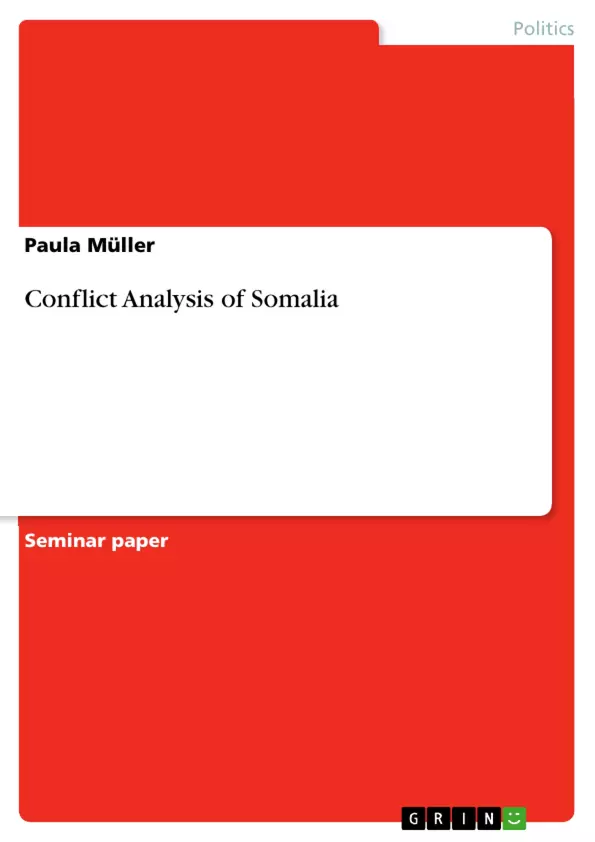The American business magazine ,,Forbes” regularly publishes among various rankings „The world’s most dangerous countries” based on crime rates, police protection, civil unrest, terrorism risk, kidnapping threat and geopolitical stability. In 2012, the top three were: Afghanistan, Iraq and Somalia. The third most dangerous country, Somalia, is also on the top of many other rankings; for instance it holds the first place of Forbes ,,Most Corrupt Countries” ahead of North Korea since 2008.56) For 22 years, there hasn’t been any established government and even international interventions by the UNO and the USA in order to stop the civil war and restore peace failed; but what are the conflicts in Somalia actually about?
This paper is going to explain the Somali civil war, it’s roots and future prospects. Therefore, it is divided in seven main chapters: geographical aspect, historical aspect, ethnic aspect, political aspect, social aspect, economic aspect and future prospects. Each aspect illustrates the particular part of the conflict and after the future prospects based on a personal assessment there will be a summary of the conflict’s main issues.
Since there is neither an established government nor any other official registration it is hard
to find reliable data and statistics. Most of them are based on estimates and cannot keep up
with the fast changes. That is why the figures in this paper may not be absolutely correct but
nevertheless they can give a general idea of Somalia’s situation.
Inhaltsverzeichnis (Table of Contents)
- Introduction
- Findings
- Chapter 1: Geographical aspect
- Chapter 2: Historical aspect
- Chapter 3: Ethnic aspect
- Chapter 4: Political aspect
- Chapter 5: Social aspect
- Chapter 6: Economic aspect
- Chapter 7: Future prospects
- Summary: the main issues of the conflict
- References
Zielsetzung und Themenschwerpunkte (Objectives and Key Themes)
This paper aims to provide a comprehensive analysis of the Somali civil war, examining its historical roots, current manifestations, and future prospects. It explores various aspects of the conflict, including geographical, historical, ethnic, political, social, and economic factors, ultimately aiming to shed light on the complex and multifaceted nature of the conflict.
- The impact of geographical factors on the conflict in Somalia
- The historical roots of the Somali civil war
- The role of ethnic tensions in perpetuating the conflict
- The challenges posed by political instability and lack of governance
- The social and economic consequences of the ongoing conflict
Zusammenfassung der Kapitel (Chapter Summaries)
- Chapter 1: Geographical aspect: This chapter explores the geographical context of Somalia, highlighting its location, climate, and environmental challenges. It discusses how these factors contribute to the complexities of the Somali conflict.
- Chapter 2: Historical aspect: This chapter examines the historical events and developments that led to the Somali civil war, tracing the origins of the conflict back to colonial influences and internal power struggles. It delves into the historical roots of Somali identity and explores how these factors contribute to the present-day conflict.
- Chapter 3: Ethnic aspect: This chapter focuses on the role of ethnicity in the Somali conflict, examining the various clans and their historical relationships. It explores how ethnic divisions and rivalries have contributed to the ongoing civil war and its complexities.
- Chapter 4: Political aspect: This chapter analyzes the political dynamics of Somalia, examining the challenges of establishing a stable and effective government. It explores the power struggles, factionalism, and external influences that have contributed to the ongoing conflict.
- Chapter 5: Social aspect: This chapter examines the social consequences of the Somali civil war, focusing on the impact on communities, individuals, and their daily lives. It explores issues such as displacement, human rights violations, and the erosion of social cohesion.
- Chapter 6: Economic aspect: This chapter analyzes the economic implications of the conflict in Somalia, examining the destruction of infrastructure, the decline of trade, and the prevalence of corruption. It explores the economic challenges facing the country and the impact on its people.
Schlüsselwörter (Keywords)
This paper focuses on the Somali civil war, exploring key aspects such as geography, history, ethnicity, politics, society, and economics. It investigates the role of these factors in fueling the conflict and its long-term consequences. The analysis centers on the complex dynamics of the conflict, examining the interplay of internal and external forces, and ultimately aiming to provide insights into the challenges of achieving peace and stability in Somalia.
- Quote paper
- Paula Müller (Author), 2013, Conflict Analysis of Somalia, Munich, GRIN Verlag, https://www.grin.com/document/450782



